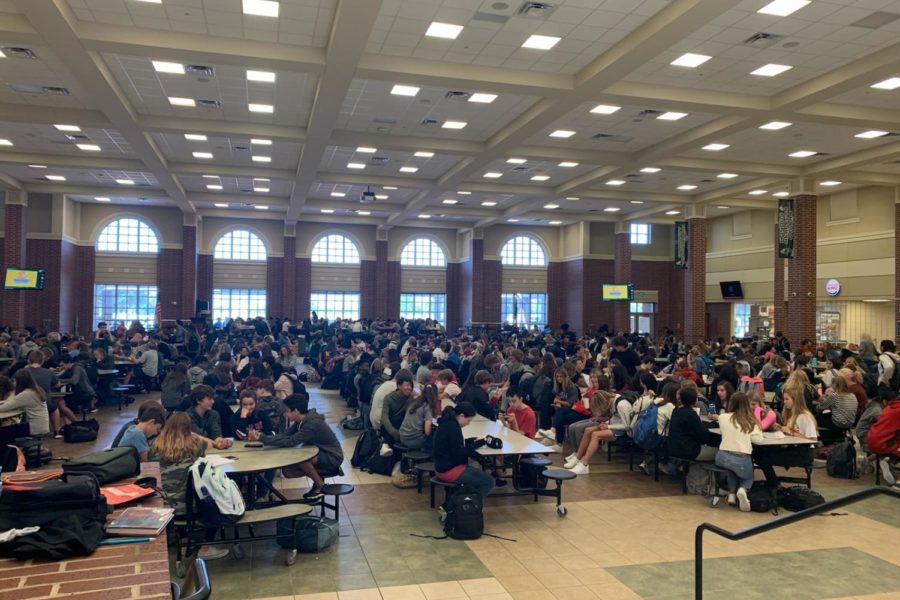Editorial: Eagle Time communication needs improvement
Before the draft system, the cafeteria faced overcrowding as pictured above on September 26. With the draft, more students stay in classrooms. “With a managed cafeteria and hallways, students’ actions are monitored and violence – as seen in the cafeteria last year – is less likely,” Assistant Editor Ryan Stanley writes in the staff editorial.
“Where am I supposed to go for Eagle Time? Am I drafted today?” Students ask these questions too often, and it has not gotten better since the Eagle Time changes. Communication between the school, teachers and students is not good enough. The issue is twofold: Eagle Time information is often not relayed to students, and the draft system is too complicated.
Improved productivity and safety
While there are issues with the new Eagle Time system, it’s more productive than before. Students are forced to work in assigned classrooms, whereas previously it was easier to slack off. In addition, fewer students stalk the halls, and the cafeteria is not as chaotic. With a managed cafeteria and hallway access, students’ actions are monitored, and violence – as seen in the cafeteria last year – is less likely.
After the Sept. 12 lock out exposed unsafe conditions in the cafeteria and on the patio, the administration introduced new Eagle Time system to increase safety. With the draft, school officials knows where students are, which allows for an easy check-out process and increased student safety. In case of an emergency, students in classrooms are safer than students in hallways or crammed in the cafeteria. However, the system is only efficient when students are in the right classroom.
Increased confusion amongst students and teachers
With the Eagle Time changes comes confusion. Third and seventh period teachers are responsible for informing students if they’re drafted or not, but they often fail to do so. This leaves students missing valuable Eagle Time instruction and stuck in classrooms where they’re not supposed to be. Not all teachers are bad with communication, and the system is difficult, which puts extra strain on their workload. Drafting can add multiple hours of work per week for teachers who have classes with multiple grade levels because of the tedious process. Also, some teachers have to share rooms for Eagle Time – again increasing stress for teachers because classroom instruction becomes difficult with more than one class of students in a single room.
Here are the rules: Priority day teachers have draft privileges over non-priority day teachers until 4:45 p.m. the day before. After that, it is a free-for-all draft until 8 a.m. when the selection process is supposed to stop. However, in reality, teachers can draft students up until noon. This creates issues for students who start the day un-drafted and plan on using Eagle Time for their needs, but they then find out in their third or seventh period that they’re drafted for a different class. This also leads to teachers drafting a student over another teacher, which creates discord between teachers and more confusion for students.
Another issue is the lack of emails informing students about their draft. According to the new Eagle Time rules, students should receive emails the morning of the day they are drafted. This has not happened. And if the rules have changed, no one has told students. The teachers’ ability to draft students until noon creates a conflict with the morning emails, which may explain why they (the emails) haven’t happened.
How to fix it?
The student body size no doubt makes Eagle Time difficult for teachers and administration to handle. Reynolds and Rogers middle schools have a successful Eagle Time system, perhaps thanks to their smaller sizes. With Rock Hill opening next year, Eagle Time could become more effective with fewer students. However, the system needs fixing now.
One simple solution: Teachers need to consistently inform students where they’re supposed to go if drafted – but that isn’t enough. Students should receive emails when they’re drafted, so they have time to talk with the teacher who drafted them to opt out if it’s not required or learn why they’re drafted. Overall, Eagle Time will run as intended if everyone respects the system and follows the rules laid out by administration. Now it’s time to fix the system, or get rid of it.
Editor’s Note: Assistant Editor Ryan Stanley wrote this editorial on behalf of the Eagle Nation Online editorial board.
Your donation will support the student journalists of Prosper High School. Your contribution will allow us to purchase equipment and cover our annual website hosting costs.













